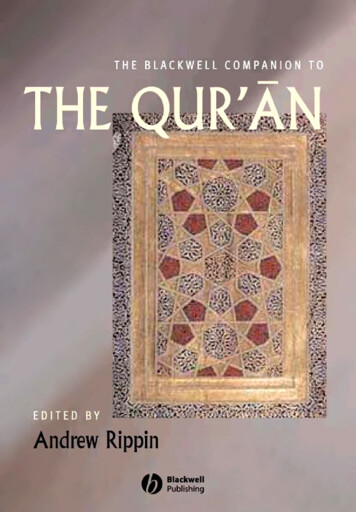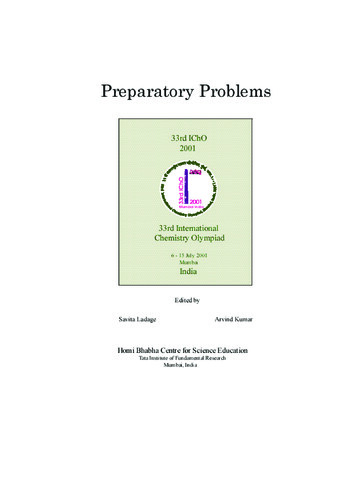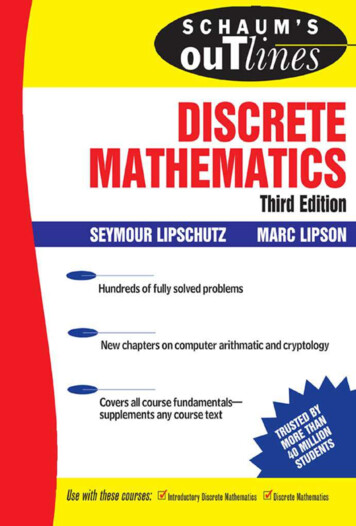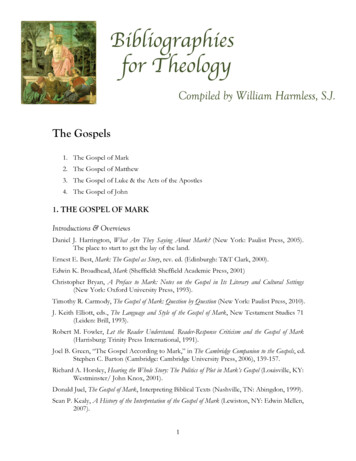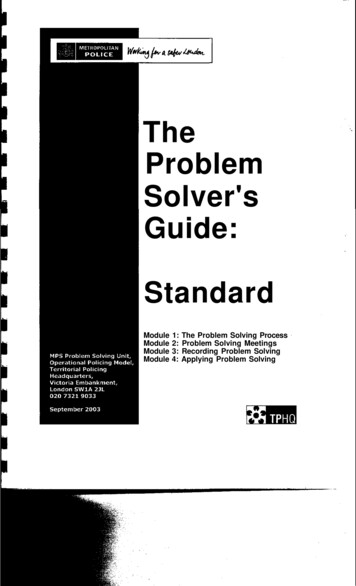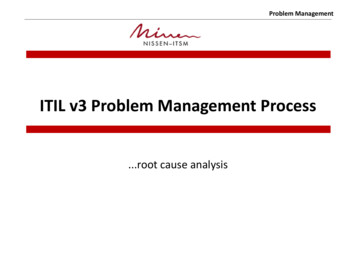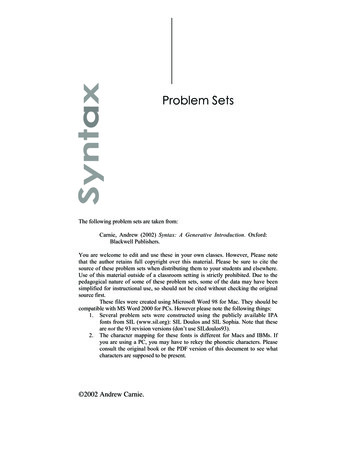
Transcription
Problem SetsThe following problem sets are taken from:Carnie, Andrew (2002) Syntax: A Generative Introduction. Oxford:Blackwell Publishers.You are welcome to edit and use these in your own classes. However, Please notethat the author retains full copyright over this material. Please be sure to cite thesource of these problem sets when distributing them to your students and elsewhere.Use of this material outside of a classroom setting is strictly prohibited. Due to thepedagogical nature of some of these problem sets, some of the data may have beensimplified for instructional use, so should not be cited without checking the originalsource first.These files were created using Microsoft Word 98 for Mac. They should becompatible with MS Word 2000 for PCs. However please note the following things:1. Several problem sets were constructed using the publicly available IPAfonts from SIL (www.sil.org): SIL Doulos and SIL Sophia. Note that theseare not the 93 revision versions (don’t use SILdoulos93).2. The character mapping for these fonts is different for Macs and IBMs. Ifyou are using a PC, you may have to rekey the phonetic characters. Pleaseconsult the original book or the PDF version of this document to see whatcharacters are supposed to be present. 2002 Andrew Carnie.
Syntax: Problem Sets4CHAPTER 11.INTUITIONSAll of the following sentences have been claimed to be ungrammatical orunacceptable by someone at some time. For each sentence, indicatewhether this unacceptability isi) a prescriptive or a descriptive judgment, andii) for all descriptive judgments indicate whether the ungrammaticality hasto do with syntax or semantics.One- or two-word answers are appropriate. If you are not a native speaker ofEnglish, enlist the help of someone who is. If you are not familiar with theprescriptive rules of English grammar, you may want to consult a writingguide or English grammar or look at Pinker’s The Language Instinct.a) Who did you see in Las Vegas?b) You are taller than me.c) My red is refrigerator.d) Who do you think that saw Bill?e) Hopefully, we’ll make it through the winter without needing the snowblower.f) My friends wanted to quickly leave the party.g) Bunnies carrots eat.h) John’s sister is not his sibling.2.INNATENESSAbove, we argued that some amount of syntax is innate (inborn). Can youthink of an argument that might be raised against innateness? (It doesn’thave to be an argument that works, just a plausible one.) Alternately, couldyou come up with a hypothetical experiment that could disprove innateness?What would such an experiment have to show? Remember that crosslinguistic variation (differences between languages) is not an argumentagainst innateness or UG, because UG contains parameters that allowminute variations.3.PRESCRIPTIVE RULESIn the text above, we argued that descriptive rules are the primary focus ofsyntactic theory. This doesn’t mean that prescriptive rules don’t have their 2002, Andrew Carnie
Syntax: Problem Sets5uses. What are these uses? Why do we maintain prescriptive rules in oursociety?4.UNIVERSALSPretend for a moment that you don’t believe Chomsky and that you don’tbelieve in the innateness of syntax (but only pretend!). How might youaccount for the existence of universals (see definition above) acrosslanguages?5.LEARNING VS. ACQUISITIONWe have distinguished between learning and acquiring knowledge. Learningis conscious, acquisition is automatic and subconscious. (Note that acquiredthings are not necessarily innate. They are just subconsciously obtained.)Other than language are there other things we acquire? What other things dowe learn? What about walking? or reading? or sexual identity? An importantpoint in answering this question is to talk about what kind of evidence isnecessary to distinguish between learning and acquisition.6.LEVELS OF ADEQUACYBelow, you’ll find the description of several different linguists’ work. Attributea level of adequacy to them (state whether the grammars they developed areobservationally adequate, descriptively adequate, or explanatorily adequate.Explain why you assigned the level of adequacy that you did.a) Juan Martínez has been working with speakers of Chicano English in thebarrios of Los Angeles. He has been looking both at corpora (rap music,recorded snatches of speech) and working with adult native speakers.b) Fredrike Schwarz has been looking at the structure of sentences ineleventh-century Welsh poems. She has been working at the nationalarchives of Wales in Cardiff.c) Boris Dimitrov has been working with adults and corpora on theformation of questions in Rhodopian Bulgarian. He is also conducting alongitudinal study of some two-year-old children learning the language to testhis hypotheses. 2002, Andrew Carnie
Syntax: Problem Sets7.6ANAPHORAIn this chapter, as an example of the scientific method, we looked at thedistribution of anaphora (nouns like himself, herself, etc.). We came to thefollowing conclusion about their distribution:An anaphor must agree in person, gender, and number with its antecedent.However, there is much more to say about the distribution of these nouns (infact, chapter 4 of this book is entirely devoted to the question).Part 1: Consider the data below. Can you make an addition to the abovestatement that explains the distribution of anaphors and antecedents in thevery limited data below?a)b)c)d)Geordi sang to himself.*Himself sang to Geordi.Betsy loves herself in blue leather.*Blue leather shows herself that Betsy is pretty.Part 2: Now consider the following sentences:1e) Everyone should be able to defend himself/herself/themselves.f) I hope nobody will hurt themselves/himself/?herself.Do these sentences obey your revised generalization? Why or why not? Isthere something special about the antecedents that forces an exception here,or can you modify your generalization to fit these cases?CHAPTER 21.PART OF SPEECH 12Identify the main parts of speech (i.e., Nouns, Verbs, Adjectives/Adverbs,and Prepositions) in the following sentences. Treat hyphenated words assingle words:a) The old rusty pot-belly stove has been replaced.12Thanks to Ahmad Lotfi for suggesting this part of the question.Problem set contributed by Sheila Dooley-Collberg. 2002, Andrew Carnie
Syntax: Problem Sets7b) The red-haired assistant put the vital documents through the newefficient shredder.c) The large evil leathery alligator complained to his aging keeper about hisextremely unattractive description.d) I’ve just eaten the last piece of chocolate cake.2.PART OF SPEECH 2Consider the following selection from Jabberwocky, a poem by Lewis Carroll:Twas brillig and the slithy tovesDid gyre and gimble in the wabe;All mimsy were the borogoves,And the mome raths outgrabe.“Beware the Jabberwock, my son!The jaws that bite, the claws that catch!Beware the Jubjub bird, and shunThe frumious bandersnatch!”He took his vorpal sword in hand:Long time the manxone foe he sought –So rested he by the tumtum treeAnd stood a while in thought.And as in uffish thought he stoodThe Jabberwock with eyes of flame,Came whiffling through the tulgey wood,and burbled as it came.For each underlined word, indicate its part of speech (word class), andexplain the distributional criteria by which you came up with thatclassification. Do not try to use a dictionary. Most of these words arenonsense words. You will need to figure out what part of speech they arebased upon what suffixes and prefixes they take, along with where theyappear relative to other words. (See the appendix above.)3.NOOTKA(Data from Sapir and Swadesh 1939)Consider the following data from Nootka, a language spoken in BritishColumbia, Canada. (The : mark indicates a long vowel. is a glottal stop. 2002, Andrew Carnie
Syntax: Problem Sets8PRES in the second line means “present tense,” DEF means “definitedeterminer” (the).)a)Mamu:k-maworking-PRES“The man is working.”qu: as- i.man-DEFb)Qu: as-mamamu:k- i.working-DEFman-PRES“The working one is a man.”Questions about Nootka:1) In sentence a, is Qu: as a verb or a noun?2) In sentence a, is Mamu:k a verb or a noun?3) In sentence b, is Qu: as a verb or a noun?4) In sentence b, is Mamu:k a verb or a noun?5) What criteria did you use to tell what is a noun in Nootka and what is averb?6) How does this data support the idea that there are no semantic criteriainvolved in determining the part of speech?4.ENGLISHDraw phrase structure trees and bracketed diagrams for each of the followingsentences, indicate all the categories (phrase (e.g., NP) and word level (e.g.,N)) on the tree. Use the rules given above in the summary of this chapter. Becareful that items which modify one another are part of the same constituent.Treat words like can, should, might, was, as instances of the category T3(tense).a) The very young child walked from school to the store.b) John paid a dollar for a head of lettuce.c) Teenagers drive rather quickly.d) A clever magician with the right equipment can fool the audience easily.e) The police might plant the drugs in the apartment.f) Those Olympic hopefuls should practice diligently every day.g) The latest research on dieting always warns people about the dangers oftoo much cholesterol.h) That annoying faucet was dripping constantly every day for months.3Thanks to Sheila Dooley Collberg for contributing sentences d–h. 2002, Andrew Carnie
Syntax: Problem Sets5.9AMBIGUITYThe following English sentences are all ambiguous. Provide a paraphrase (asentence with roughly the same meaning) for each of the possible meanings,and then draw (two) trees of the original sentence that distinguish the twomeanings. Be careful not to draw the tree of the paraphrase. Your two treesshould be different from one another, where the difference reflects whichelements modify what. (For sentence (b) ignore the issue of capitalization.)a) John said Mary went to the store quickly.b) I discovered an old English poem.6.STRUCTUREIn the following sentences a sequence of words is marked as a constituentwith square brackets. State whether or not it is a real constituent, and whatcriteria (that is constituency tests) you applied to determine that result.a) Susanne gave [the minivan to Petunia].b) Clyde got [a passionate love letter from Stacy].7.CONSTITUENCY TESTS (ADVANCED) 4Do the words in boldface in the following sentence form a single constituent?That is, is there a [Barbie and Ken kissing] constituent? How do you know?Use all the tests available to you.Barbie and Ken were seen by everyone at the party kissing.A couple of things may help you in this problem. (1) Remember, thatconstituents can be inside other constituents. (2) This sentence is a passive,which means that some movement has happened, so don’t let the fact thatthere is other stuff in between the two bits throw you off.8.ENGLISH PREPOSITIONSIn the text, we claimed that perhaps the NP in PPs was optional, explainingwhy we can say He passed out, where the preposition out has no object.Consider an alternative: the expression [passed out] is really a “complex”4Sheila Dooley Collberg is the source of this problem set. 2002, Andrew Carnie
Syntax: Problem Sets10verb. Using constituency tests, provide arguments that the structure ofexpressions like:a)b)c)d)He blew out the candle.He turned off the light.He blew up the building.He rode out the storm.is really [[V P] NP] rather than: [V [P NP]].9.BAMBARA(Data from Koopman 1992)Consider the following data from Bambara, a Mande language spoken inMali. (The glosses have been slightly simplified.) Pay careful attention to thesecond line, where the word order of Bambara is shown.a) A kasi-ra.he cried“He cried.”b) A kaa-ra.she went“She went.”c) DenyejichildPASTwater“The child drank water.”min.drinkd) N son-na a ma.I agreed it to“I agreed to it.”Answer the following questions about Bambara:1) Is there a gender distinction in Bambara?2) Do you need a T category in Bambara?3) Is there a Determiner category in Bambara?4) What is the NP (if you need one) for Bambara?5) What is the PP rule for Bambara?6) What is the VP rule for Bambara?7) What is the S rule for Bambara? (Keep in mind your answers to theabove questions – be consistent.) 2002, Andrew Carnie
Syntax: Problem Sets118) Draw trees for (a), (c), and (d) using your rules.9) Draw bracketed diagrams for (b) and (c).10.HIXKARYANA(Data from Derbyshire 1985)Look carefully at the following data from a Carib language from Brazil (theglosses have been slightly simplified from the original):a) Kurahayonyhoryenobowmade“The boy made a bow.”biyekomo.boyb) Newehyatxheworiskomo komo.take-bathwomenall“All the women take a bath.”c) Totoheno komoyonoye kamara.persondead allatejaguar“The jaguar ate all the people.”Now answer the following questions about Hixkaryana:1)Is there any evidence for a determiner category in Hixkaryana? Besure to consider quantifier words as possible determiners (like some and all).2)Is there evidence for an AP rule in Hixkaryana?3)Posit an NP rule to account for Hixkaryana. (Be careful to do it forthe second line, the word-by-word gloss, in these examples not the thirdline.)4)Posit a VP rule for Hixkaryana.5)Posit an S rule for Hixkaryana.6)What is the part of speech of newehyatxhe? How do you know?7)Draw the trees for (a) and (c) using the rules you posited above.(Hint: if your trees don’t work, then you have probably made a mistake in therules.)8)Give bracketed diagrams for the same sentences. 2002, Andrew Carnie
Syntax: Problem Sets10.12IRISH(Data from Carnie field notes)Consider the following data from Modern Irish Gaelic.a) Phóg LiamSéan.kissed William John“William kissed John.”b) Phóg Seán Liam.Kissed John William“John kissed William.”c) Phóg an fear an mhuc.kissed the man the pig“The man kissed the pig.”d) Chonaic mé an mhuc mhór.SawI the pig big“I saw the big pig.”e) Rincean bheán.Dancedthe woman“The woman danced.”On the basis of this data answer the following questions:1) Is there any evidence for an AP category in Irish?2)Write the NP rule for Irish, be sure to mark optional things inparentheses.3)Can you write a VP rule for Irish? Assume that object NPs (likeWilliam in (b) and the big pig in (d)) must be part of the VP, and that subjectNPs (like John in (b) and I in (d)) are never part of VPs.4)What is the S rule for Irish? (Be careful that your S rule is consistentwith your answer in (3).)5) Using the rules you developed, draw trees for sentences (c), (d) and (e). 2002, Andrew Carnie
Syntax: Problem Sets13CHAPTER 31.STRUCTURAL RELATIONS I5Consider the following es fromD3theNP3N3grocer1)What node(s) dominate grocer?2)What node(s) immediately dominate D3 the?3)Do will and buy form a constituent?4)What nodes does N1 bully c-command?5)What nodes does NP1 the big bully c-command?6)What is V buy’s mother?7)What nodes does will precede?8)List all the sets of sisters in the tree.9)What is the PP’s mother?10)Do NP1 and VP asymmetrically or symmetrically c-command oneanother?11)List all the nodes c-commanded by V.12)What is the subject of the sentence?13)What is the object of the sentence?14)What is the object of the preposition?15)Is NP3 a constituent of VP?16)What node(s) is NP3 an immediate constituent of?17)What node(s) does VP exhaustively dominate?18)What is the root node?19)List all the terminal nodes.20)What immediately precedes N3 grocer?5The idea for this problem set is borrowed from Radford (1988). 2002, Andrew Carnie
Syntax: Problem Sets2.14TREESUsing the rules we developed in chapter 2, draw the trees for the followingsentences:a)b)c)d)e)f)The big man from New York loves bagels with cream cheese.Susan rode a bright blue train from New York.The plucky platypus kicked a can of soup from New York to Tucson.John said Martha sang the aria with gusto.Martha said John sang the aria from La Bohème.The book of poems from the city of Angels with the bright red coverstinks.g) Louis hinted Mary stole the purse deftly.h) The extremely tired students hated syntactic trees with a passion.i) Many soldiers have claimed bottled water quenches thirst best.j) Networking helps you grow your business.3.STRUCTURAL RELATIONS IILook at your tree for sentence (a) of question 2.1)2)3)4)5)6)7)8)9)10)11)List all the nodes that the subject NP c-commands.List all the nodes that the subject NP asymmetrically c-commands.List all the nodes that the subject NP dominates.List all the nodes that the subject NP immediately dominates.List all the nodes that the subject NP precedes.List all the nodes that the VP node c-commands.List all the nodes that the VP asymmetrically c-commands.List all the nodes that the VP dominates.List all the nodes that the VP immediately dominates.List all the nodes that the VP precedes.List all the nodes that the VP follows (i.e., is preceded by).4.NEGATIVE POLARITY ITEMSThere is a class of phrase, such as [a red cent] and [a single thing], that arecalled Negative Polarity Items (NPI). These are only allowed in sentenceswith a negative word like not. So for example, in sentences (a) and (c) theNPI is fine, in the (b) and (d) sentences, however, the sentence is at beststrange.a) I didn’t have a red cent.b) *I had a red cent. (ungrammatical with idiomatic reading) 2002, Andrew Carnie
Syntax: Problem Sets15c) I didn’t read a single book the whole time I was in the library.d) *I read a single book the whole time I was in the library.It turns out that sentences with NPIs not only must have a word like not, theyalso have to be in a particular structural relationship with that not word. Onthe basis of the following sentences figure out what that relationship is. Thereare two possible answers consistent with this data.e) I did not have a red cent.f) *A red cent was not found in the box.5.GRAMMATICAL RELATIONS6For each of the following sentences, identify the subject, the object (if there isone), the indirect object (if there is one), any objects of prepositions, the verb,and any adverbs.a)It never rains violently in southern California.b)Soon we should give the family dog another bath.c)The quiz show contestant bravely made a wild guess about theanswer.6.TZOTZIL(Data from Aissen 1987)Tzotzil is a Mayan language spoken in Mexico. Consider the followingsentences, then answer the questions that follow. Glosses have beensimplified and the orthography altered from the original source.a) ’ispet lok’el ’antzti t’ule.carry away woman the rabbit“The rabbit carried away (the) woman.”b) ’ibat xchi’uk smalalli Maruche.go withher-husband the Maruch“(the) Maruch went with her husband.” (Maruch is a proper name.)c) Pas ti ’eklixa’une.built the church“The church was built.”6Problem set contributed by Sheila Dooley Collberg. 2002, Andrew Carnie
Syntax: Problem Sets161) What is the NP rule for Tzotzil?2) What is the PP rule for Tzotzil?3) What is the VP rule for Tzotzil?4) What is the S rule for Tzotzil?5) What is the subject of sentence (b)?6) Is [the church] a subject or an object of sentence (c)?7) Does the verb precede the subject in Tzotzil?8) Does the object precede the subject in Tzotzil?9) Does the verb precede the object in Tzotzil?10) Using the rules you developed in (1)–(4) above, draw the trees for (b)and (c).7.HIAKI(Data from Dedrick and Casad 1999)Consider the data from the following sentences of Hiaki (also known asYaqui), an Uto-Atzecan language from Arizona and Mexico. Data have beensimplified.a) Tékilné-u’aáyu-k.workme-for is“There is work for me.” (literally: “Work is for me.”)b) Hunáa’a yá’uraa hunáka’a hámutta nokriak.thatchief thatwoman defend“That chief defended that woman.”c) Taáwe tótoi’asó’olam káamomólim híba-tu’ure.Hawk chickensyounglike“(The) hawk likes young chickens.”d) Tá’abwikasu’áma yépsak.different-personthere arrived“A different person arrived there.”(assume there is an adverb)1) What is the NP rule for Hiaki?2) Do you need a PP rule for Hiaki? Why or why not?3) What is the VP rule for Hiaki?4) What is the S rule for Hiaki?5) Using the rules you developed in questions 1–4, draw the tree forsentences (b, c, d).6) What is the subject of sentence (b)? 2002, Andrew Carnie
Syntax: Problem Sets7)8)9)10)11)12)13)14)15)16)17Is there an object in (d)? If so, what is it?What node(s) does hunáa’a c-command in (b)?What node(s) does hunáa’a yá’uraa c-command in (b)?What does ’áma precede in (d)?What node immediately dominates káamomólim in (c)?What nodes dominate káamomólim in (c)?What node immediately precedes káamomólim in (c)?What nodes precede káamomólim in (c)?Does káamomólim c-command táawe in (c)?Do hunáka’a and hámutta symmetrically c-command one another in (b)?CHAPTER 41.BINDING PRINCIPLESExplain why the following sentences are ungrammatical:a)b)c)d)e)f)2.*Michaeli loves himi.*Hei loves Michaeli.*Michaeli’s fatherj loves himselfi.*Michaeli’s fatherj loves himj.*Susani thinks that John should marry herselfi.*John thinks that Susani should kiss heri.JAPANESE(Data from Aikawa 1994)Japanese has a number of items that can be called pronouns or anaphors.One of these is zibunzisin. For the purposes of this assignment assume thatany noun that has the suffix -wa c-commands any other NP, and assume thatany noun that has the suffix -ga c-commands any NP with the suffix -o.Consider the following data:a) Johnwai [S’ [S Marygak zibunzisinok/*i hihansita] [C to]] itta.JohnMaryzibunzisincriticized that said“John said that Maryk criticized herselfk.”“*Johni said that Mary criticized himselfi.” 2002, Andrew Carnie
Syntax: Problem Sets18Question 1: On the basis of only the data in (a) is zibunzisin an anaphor or apronoun? How can you tell?Now consider this sentence:b) Johnwai [S’ [S zibunzisingai Maryo korosita] [C to]] omotteiru.JohnzibunzisinMary killedthat think“John thinks that himself killed Mary.”(note: grammatical in Japanese.)Question 2. Given this additional evidence, do you need to revise yourhypothesis from question 1? Is zibunzisin an anaphor, a pronoun orsomething else entirely? How can you tell?One more piece of data:c) *Johnwai [S’[S zibunzisingak Maryok korosita] [C to]] omotteiru.JohnzibunzisinMary killedthat think“*John thinks that herselfk killed Maryk.”Question 3. Sentence (c) is a violation of which binding principle? (A, B, orC?) Which noun is binding which other noun in this sentence to cause theungrammaticality?3.WH-QUESTIONSWhat problem(s) does the following sentence make for the binding theory?Can you think of a solution? (Hint: consider the non-question form of thissentence John despises these pictures of himself.)Which pictures of himselfi does Johni despise?Assume the following tree for this sentence:S'NPCompdoesDNWhich picturesPPPofNPiNhimself 2002, Andrew CarnieSNPiVPNJohnVdespise
Syntax: Problem Sets4.19COUNTEREXAMPLES?7Each of the following examples is problematic for the binding theory weformulated above. Briefly explain why. For data from languages other thanEnglish, your answer should be based on the facts of the target language,and not the English translations. Use the word-by-word glosses to determinewhether the Dogrib and Modern Greek NPs should be analyzed as anaphors,pronouns or R-expressions. Your discussion of Dogrib should be based onconsideration of both sentences.a) I have no money on me.b) John knew that there would be a picture of himself hanging in the postoffice.c) Modern GreekO Yanisi ipe stin Katerina oti i Maria aghapa ton idhioi.Johnsaid to Catherin that Mary loves himself“Johni told Catherine that Mary loves himi/*k.”d) Dogrib(i) Johnye-hk’èJohn3SG( him)-shoot“Johni is going to shoot himk/*i.”hafuture(ii) *ye-zhashèeti3SG( his)-son ate“His son ate.”5.PERSIAN8Does the binding theory account for the following data? Explain. (Râ means“the” when following object NPs. 3SG means “third person singular”.)bargardune]].a) Jâni goft [S’ ke [S Meryk ketâb-â ro be xodeshi/kJohn said that Mary book-PL râ to himself/herself return“John said that Mary (should) return the books to him/herself.”78This problem set was contributed by Betsy Ritter. The Dogrib data come from Saxon (1984).This problem set was contributed by Simin Karimi. 2002, Andrew Carnie
Syntax: Problem Sets20b) Jâni goft [S’ ke [s Meryj ketâb-â ro be xodeshi/jbarmigardune]].John said that Mary book-PL râ to himself/herself return3SG.FUT“John said that Mary will return the books to him/herself.”Now consider (c) and (d): in these examples, xod ‘self’, instead of xodesh‘himself’, is used. How do you explain the contrast between (a and b) and (cand d)? Note that (a and b) are taken from the spoken language, whereas (cand d) represent the formal written variant.c) Jâni goft [ke [S Meryk ketâb râ barâye xod*i/kbexânad]].John said that Mary book râ forselfread3SG“John said that Mary (should) read the book to *himself/herself.”barâye xod*i/k negahdârad]].d) Jâni goft [ke [S Meryk ketâb râJohn said that Mary book râ forselfkeep3SG“John said that Mary (should) keep the books for *himself/herself.”6.C-COMMAND OR PRECEDENCE?In the text above, we proposed that binding required both c-command andcoindexation. Consider an alternative: binding requires that the antecedentprecedes (rather than c-commands) and is coindexed with the anaphor orpronoun. Which of these alternatives is right? How can you tell? You mightconsider data such as the following:a) [S' [S'Although hei loves marshmallows] [S Arti is not a big fan of Smores]].b) [S [NP Hisi yearbook picture] gives Tomi the creeps].CHAPTER 51.TREESDraw the X-bar theoretic trees for the following sentences:a) Abelard wrote a poem about Héloïse.b) Abelard wrote a poem with Héloïse in mind.c) Abelard wrote a poem with Héloïse’s pen.d) The red volume of obscene verse from Italy shocked the puritan soul ofthe minister with the beard quite thoroughly yesterday.e) The biggest man in the room said that John danced an Irish jig fromCounty Kerry to County Tipperary all night long. 2002, Andrew Carnie
Syntax: Problem Sets2.GERMAN NOUN PHRASESConsider sentence (a) from German:a)219Die schlanke Frau aus Frankreich isst Kuchen mit Sahne.the thin woman from Franceeats cake with cream“The thin woman from France eats cake with cream.”The following sentences are grammatical if they refer to the same womandescribed in (a):b)Die Schlanke aus Frankriech isst Kuchen mit Sahne.“The thin one from France eats cake with cream.”c)Die aus Frankriech isst Kuchen mit Sahne.“The one from France eats cake with cream.”d)Die Schlanke isst Kuchen mit Sahne.“The thin one eats cake with cream.”e)Die isst Kuchen mit Sahne.“She eats cake with cream.”Now consider sentences (f–i):f)Die junge Koenigin von England liebte die Prinzessin.The young queen of England loved the princess“The young queen of England loved the princess.”g)Die junge liebte die Prinzessin.“The young one loved the princess.”h)Die liebte die Prinzessin.“She loved the princess.”i)*Die von England liebte die Prinzessin.“the one of England loves the princess.”9Thanks to Simin Karimi for providing the data for this question. 2002, Andrew Carnie
Syntax: Problem Sets22Assume the following things:i)Der/Die are always determiners, they are never nouns or pronounsii)Schlanke, junge, are always adjectives, even in sentences (f) and (d)– assume they never become nouns. (Ignore the rules of Germancapitalization.)The questions:1) Describe and explain the process seen in (a–e) and (f–i), be sure tomake explicit reference to X-bar theory. What English phenomenon(discussed in this chapter) is this similar to? Make sure you analyze theGerman sentences not the English translations.2) Draw the trees for sentences (a) and (f). Sentence (a) requires twodifferent trees.3) Explain the ungrammaticality of (i) in terms of X-bar theory. In particularexplain the difference between it and sentence (c). Draw trees to explicateyour answer.3.JAPANESEConsider the following data from Japanese:a)Masa-ga kita.“Masa came.”b)Toru-ga shinda.“Toru died.”c)Kumiko-ga yonda.“Kumiko read.”d)Kumiko-ga hon-o yonda.“Kumiko read the book.”e)Toru-ga Kumiko-o mita.“Toru saw Kumiko.”f)Kumiko-ga Toru-o mita.“Kumiko saw Toru.”g)hon-ga akai desu.“the book is red.” 2002, Andrew Carnie
Syntax: Problem Setsh)Toru-ga sensei desu.“Toru is a teacher.”i)Masa-ga ookii desu.“Masa is big.”j)Sono hon-ga ookii desu.“that book is big.”k)Toru-ga sono akai hon-o mita.“Toru saw that red book.”231) What is the function of the suffixes -o and -ga?2) What is the word order of Japanese?3) Does the complement precede or follow the head in Japanese?4) Do adjuncts precede or follow the head in Japanese?5) Do specifiers precede or follow the X' node in Japanese?6) Draw the tree for sentence (k) using X-bar theory. Keep in mind youranswers to questions (1–5).4.PARAMETERSGo back to the foreign language problems from the previous three chapters,and see if you can determine the parameter settings for these languages.You may not be able to determine all the settings for each language.CHAPTER 61.ENGLISH THAT10Discuss the status of the word that in each of the following two sentences.Explain the differences between the two sentences. If you assign a differentcategory status to that in each sentence, explain why. Draw the tree (use Xbar theory) for each of the sentences.a) Robert thinks that students should eat asparagus.b) Robert thinks that student should eat asparagus.10Thanks to Eithne Guilfoyle for contributing this problem set. 2002, Andrew Carnie
Syntax: Problem Sets2.24SUBJECTS AND PREDICATE PHRASESIn each of the following clauses identify the subject and the predicate phrase.Some sentences contain multiple clauses, be sure to identify the subjectsand predicate phrases of all clauses.a)b)c)d)3.11The peanut butter has got moldy.The duffer's swing blasted the golf ball across the green.That Harry loves dancing is evidenced by his shiny tap shoes.The Brazilians pumped the oil across the river.CLAUSE TYPESThe following sentences are “complex” in that they contain more than oneclause. For each sentence, identify each clause. Remember main
fact, chapter 4 of this book is entirely devoted to the question). Part 1: Consider the data below. Can you make an addition to the above statement that explains the distribution of anaphors and antecedents in the very limited data below? a) Geordi sang to himself. b) *Himself sang to Geordi. c) Betsy loves herself in blue leather.
